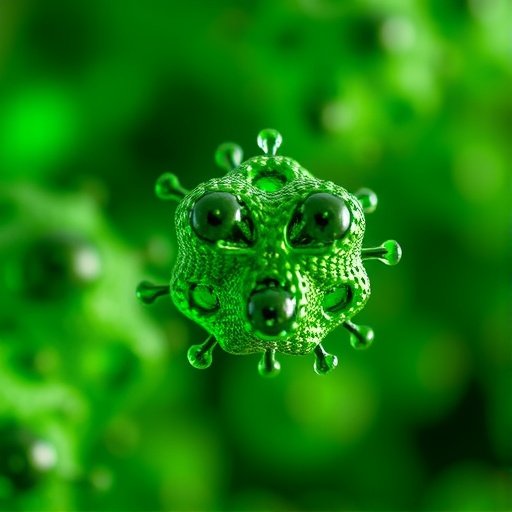Recent advancements in nanotechnology have incited compelling interest in the applications of biogenic nanoparticles, particularly silver nanoparticles (AgNPs), due to their unique properties and potential uses in various fields including medicine, agriculture, and environmental science. A recent study conducted by Covilakom et al. delves into the cytotoxic effects of silver nanoparticles synthesized using the phytochemical constituents of Nerium oleander, a plant renowned for its therapeutic properties. The findings presented provide valuable insights into the interactions between biogenic AgNPs and cellular systems, marking a significant step in the exploration of safe and effective nanomaterials.
Silver nanoparticles stand out for their broad-spectrum antimicrobial properties, making them ideal candidates for a myriad of applications, from wound dressings to water purification systems. As the demand for effective antimicrobial agents surges due to rising antibiotic resistance, silver nanoparticles continue to gain traction in the scientific community. This innovative research investigates the synthesis of silver nanoparticles through a biogenic method, leveraging plant extracts, thus offering a greener and more sustainable alternative compared to traditional chemical methods.
The study at hand highlights the synthesis process of the biogenic silver nanoparticles using Nerium oleander, which is rich in secondary metabolites. These metabolites possess various biological activities that can contribute to the reduction of silver ions to stable nanoparticles. This eco-friendly approach minimizes environmental toxicity while maximizing the functional efficacy of the nanoparticles produced. The research illustrates the potential of utilizing plants as a medium for nanoparticle synthesis, paving the way for broader applications in fields requiring natural and non-toxic materials.
One of the pivotal aspects of this study is the evaluation of the cytotoxic effects of the synthesized silver nanoparticles. Cells were exposed to varying concentrations of the nanoparticles, and assays were conducted to determine cell viability and identify any cytotoxic effects. The results demonstrated a clear relationship between nanoparticle concentration and cell viability, providing crucial data on safe dosage levels. This insight into the dose-response relationship underscores the importance of understanding how nanoparticles interact at a cellular level.
The biocompatibility of nanoparticles is a critical factor in determining their suitability for biomedical applications. The researchers made significant strides in evaluating the cellular responses elicited by silver nanoparticles synthesized from Nerium oleander. The findings suggest that while some degree of cytotoxicity was observed, the nanoparticles produced exhibited promise when employed within therapeutic ranges. This increased understanding of cytotoxicity is vital for the development of applications in targeted drug delivery systems and cancer therapies.
Moreover, the mechanism of action of the biogenic silver nanoparticles on cellular structures was investigated. The study suggests that the interaction between the nanoparticles and cellular membranes may lead to disruption and induce oxidative stress, which is a common route for nanoparticle-induced cytotoxicity. This study not only elucidates the potential risks associated with nanoparticles but also highlights the necessity for rigorous testing protocols during the development of nanomaterials for clinical use.
In previous research, the plant Nerium oleander has been recognized for its medicinal properties, including cardioprotective and anticancer effects. Hence, the utilization of this plant for silver nanoparticle synthesis raises intriguing questions about the synergistic effects that might occur when combining its natural bioactive compounds with nanoparticles. The dual action of the plant constituents and the nanoparticles themselves may yield enhanced therapeutic potential and should be investigated further in future studies.
The researchers further discuss the implications of their findings in real-world applications. The biogenic silver nanoparticles could find extensive use in developing antimicrobial coatings, enhancing food safety, and even in agricultural applications to promote plant health. The safety profile associated with plant-mediated synthesis may also help alleviate public concerns about the toxicity associated with more conventional synthetic nanoparticles.
As the field moves forward, it is vital to establish a comprehensive safety regulation framework in nanotechnology. The results of the study serve as a catalyst for future investigations aimed at understanding the long-term implications of using biogenic nanoparticles in various environments. The potential health risks associated with these particles, particularly when they enter waterways or soil, must be meticulously examined to ensure environmental safety.
Moreover, the unique properties of the silver nanoparticles synthesized from Nerium oleander open doors to innovative formulations for therapeutic uses. The ability to control the size and shape of nanoparticles during synthesis could lead to optimized formulations tailored specifically for targeted therapies, enhancing drug efficacy while minimizing side effects.
In addition, the role of nanotechnology in combating global health crises cannot be overstated. As bacterial infections become increasingly resistant to conventional antibiotic treatment, innovative solutions like biogenic silver nanoparticles could provide a feasible alternative. The continuous exploration of biosynthesized materials could help bridge the gap between traditional healthcare practices and modern technological advancements.
In conclusion, the study conducted by Covilakom et al. emphasizes the potential of biogenic silver nanoparticles as versatile agents in combating pathogenic microorganisms while also raising awareness regarding their cytotoxic effects. The findings present invaluable contributions to the understanding of nanoparticle safety and efficacy, establishing a foundation for further research that could lead to new applications in medicine and beyond. The collaboration between disciplines such as botany, medicine, and nanotechnology is essential to address the challenges posed by nanomaterials effectively.
As the scientific community further investigates the capabilities of biogenic nanoparticles, we can anticipate groundbreaking advancements that will transform various spheres, from healthcare to environmental sustainability. The successful emission of safe and effective nanosolutions signifies the dawn of a new era, where nature and technology combine to forge innovative pathways for human benefit.
Subject of Research: Evaluation of cytotoxic effects of biogenic silver nanoparticles synthesized from Nerium oleander.
Article Title: Evaluation of cytotoxic potential of biogenic silver nanoparticles Phytofabricated using Nerium oleander.
Article References:
Covilakom, P.K.K., Habeeb, H. & Thoppil, J.E. Evaluation of cytotoxic potential of biogenic silver nanoparticles Phytofabricated using Nerium oleander.
Environ Sci Pollut Res (2025). https://doi.org/10.1007/s11356-025-37088-7
Image Credits: AI Generated
DOI: 10.1007/s11356-025-37088-7
Keywords: Silver nanoparticles, biogenic synthesis, Nerium oleander, cytotoxicity, nanotechnology




